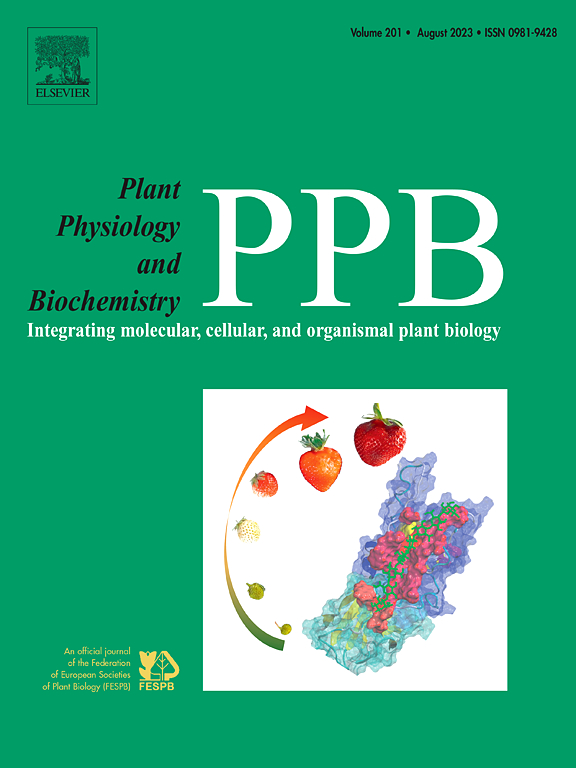马竹(Dendrocalamus latiflorus Munro) DREB基因的功能和表达分析揭示了DREB基因在非生物胁迫适应中的作用
IF 5.7
2区 生物学
Q1 PLANT SCIENCES
引用次数: 0
摘要
马竹(Dendrocalamus latiflorus Munro)是南亚重要的巨型竹材,对非生物胁迫高度敏感。脱水响应元件结合(DREB)转录因子(TFs)是一个重要的基因家族,参与植物生长、代谢调节和环境响应。尽管DREB TFs在植物生长、代谢调节和环境响应中的作用已经得到了很好的研究,但对马竹的了解却很少。为了解决这一空白,我们系统地鉴定和功能预测了马竹的DREB基因,重点研究了它们在应激反应机制中的潜在参与。通过全基因组分析,鉴定出42个dldreb,分布在6个亚家族中。综合分析包括顺式元件、染色体定位、系统发育关系、蛋白质-蛋白质相互作用(PPI)网络和基因本体(GO)注释,揭示了它们在发育过程、代谢调节和应激适应中的推测作用。RT-qPCR分析表明,8种dldreb在寒冷、盐和干旱处理下表现出不同的胁迫特异性表达模式,强调了它们对非生物胁迫恢复能力的关键贡献。三个候选基因(DREB9-A, DREB10-B和DREB12-C)优先进行功能验证。随后的克隆、序列表征、亚细胞定位分析和DNA结合分析证实了它们的调控潜力。值得注意的是,DREB10-B和DREB12-C被发现直接结合GA2ox7的启动子,GA2ox7是参与非生物应激信号传导的关键基因,这表明它们在应激反应途径中的机制作用。此外,烟草瞬时转化实验和酵母转化实验表明,过表达DREB10-B和DREB12-C可能提高植物的抗逆性。综上所述,本研究为阐明马竹DREB基因家族非生物胁迫响应的分子机制提供了理论依据。本文章由计算机程序翻译,如有差异,请以英文原文为准。

Functional and expression profiling of DREB genes in Ma Bamboo (Dendrocalamus latiflorus Munro) reveals their role in abiotic stress adaptation
Ma bamboo (Dendrocalamus latiflorus Munro) is a key giant bamboo in South Asia, highly sensitive to abiotic stresses. Dehydration-Responsive Element-Binding (DREB) transcription factors (TFs) are an important gene family involved in plant growth, metabolic regulation, and environmental responses. Although the roles of DREB TFs in plant growth, metabolic regulation, and environmental responses are well studied, little is known in Ma bamboo. To address this gap, we systematically identified and functuonally predicted DREB genes in Ma bamboo, with emphasis on their potential involvement in stress response mechanisms. Through genome-wide analysis, 42 DlDREBs distributed across 6 subfamilies were identified. Integrative analyses encompassin cis-element, chromosomal localization, phylogenetic relationships, protein-protein interaction (PPI) network, and gene ontology (GO) annotations revealed their putative roles in developmental processes, metabolic modulation, and stress adaptation. RT-qPCR profiling demonstrated that eight DlDREBs exhibit distinct and stress-specific expression patterns under cold, salt, and drought treatments, underscoring their pivotal contributions to abiotic stress resilience. Three candidate genes (DREB9-A, DREB10-B, and DREB12-C) were prioritized for functional validation. Subsequent cloning, sequence characterization, subcellular localization analysis, and DNA binding assays confirmed their regulatory potential. Notably, DREB10-B, and DREB12-C were found to directly bind the promoter of GA2ox7, a key gene implicated in abiotic stress signaling, suggesting their mechanistic role in stress-responsive pathways. Furthermore, transient transformation assays in tobacco and yeast transformation experiments demonstrated that overexpression of DREB10-B and DREB12-C may enhance plant stress tolerance. In summary, this study provides a theoretical basis for clarifying the molecular mechanism of the abiotic stress responses of the DREB gene family in Ma bamboo.
求助全文
通过发布文献求助,成功后即可免费获取论文全文。
去求助
来源期刊
CiteScore
11.10
自引率
3.10%
发文量
410
审稿时长
33 days
期刊介绍:
Plant Physiology and Biochemistry publishes original theoretical, experimental and technical contributions in the various fields of plant physiology (biochemistry, physiology, structure, genetics, plant-microbe interactions, etc.) at diverse levels of integration (molecular, subcellular, cellular, organ, whole plant, environmental). Opinions expressed in the journal are the sole responsibility of the authors and publication does not imply the editors'' agreement.
Manuscripts describing molecular-genetic and/or gene expression data that are not integrated with biochemical analysis and/or actual measurements of plant physiological processes are not suitable for PPB. Also "Omics" studies (transcriptomics, proteomics, metabolomics, etc.) reporting descriptive analysis without an element of functional validation assays, will not be considered. Similarly, applied agronomic or phytochemical studies that generate no new, fundamental insights in plant physiological and/or biochemical processes are not suitable for publication in PPB.
Plant Physiology and Biochemistry publishes several types of articles: Reviews, Papers and Short Papers. Articles for Reviews are either invited by the editor or proposed by the authors for the editor''s prior agreement. Reviews should not exceed 40 typewritten pages and Short Papers no more than approximately 8 typewritten pages. The fundamental character of Plant Physiology and Biochemistry remains that of a journal for original results.

 求助内容:
求助内容: 应助结果提醒方式:
应助结果提醒方式:


